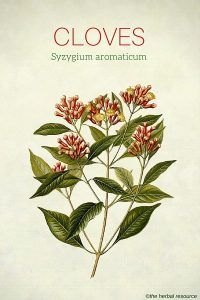Cloves contain 12-26% oil, with eugenol (70-90%) and beta-caryophyllene (as high as 7%) as the main constituents. Other ingredients found in the oil are furfural, methyl salicylate and alpha-pinene.
The composition of the essential oil can vary depending on the quality and origin of the clove tree. Eugenol inhibits prostaglandin and explains the analgesic and anti-inflammatory properties of cloves.
Cloves also contain rubber, mucins, tannins, vitamins and minerals.
Cloves Uses in the Past and History
The oldest recorded medical use of cloves, as early as 240 BC, comes from China, where it was used as a remedy for many different ailments, including diarrhea and hernia.
The Chinese nobility used it against bad breath and it was common to have cloves placed in the mouth when in audiences with the Emperor.
The clove was first introduced to Europe a few centuries after Christ’s birth and was then regarded as a luxury spice. Merchants from the Middle East who brought it with them kept the country of origin secret to keep the prices up.
It was only centuries later during the Middle Ages that the Portuguese gained monopoly when they discovered and occupied the Moluccas.
In 1605 the Dutch gained control of the island Amboina, one of the islands belonging to the Moluccas and took over the clove export and agricultural business. In order to maintain complete control of all the export, they ordered that all clove-trees should be destroyed on the remaining islands.
It was first in the 1770s that the French succeeded to smuggle seeds and seedlings out of the Moluccas to Mauritius. From there, the plant spread further to Reunion and French Guiana and from there to Zanzibar and Madagascar.
Today, Indonesia and Madagascar are the largest producers of cloves in the world.
Herbal Resource
Latest posts by Herbal Resource (see all)
- What is Maritime Pine Bark used for? - December 23, 2023

Leave a Reply